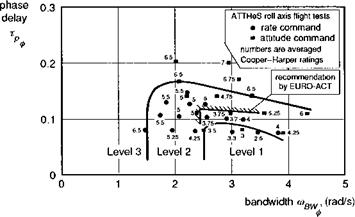Civil applications
The bandwidth criterion aims to discern handling qualities that avoid or exacerbate the problems that some pilots experience when ‘tightening-up’ in a closed-loop compensatory tracking task. For obvious reasons this high precision/performance criterion has
|
Fig. 6.32 Proposed roll axis bandwidth criteria from European tests (Refs 6.36, 6.37) |
0 1 2 3 4 5
(rad/s)
Fig. 6.33 Bandwidth/phase delay criteria for roll axis tracking task according to ADS-33D
(Ref. 6.38)
broad application across military helicopter uses. Considering civil helicopter design, certification and operations, there are several application areas that could potentially benefit from bandwidth (Ref. 6.39). Precise positioning of an underslung load is a good example, although even the military requirements are, at the time of writing, fairly immature in this area. All-weather operations requiring recoveries to moving decks is another example. The whole area of search and rescue is one where civil (and military) helicopters can be flown close to the pilot’s limits, with the requirements for precise positioning in confined spaces. With safety as an emphasis in civil helicopter operations, the case for introducing civil MTEs that include high-precision elements into the certification process is considered to be strong. The future application of ACT to civil helicopters, with the potential for increased phase delay, will strengthen this case; it is far better to highlight potential problems in certification than to experience them for the first time in operation. Of course, one of the great strengths of substantiated criteria, like bandwidth, is that they can be used in the design process to ensure satisfactory flying qualities are built in, with the aim of making the certification process a formality.












